
Tetenal's BW reversal kit
Transparencies from normal black and white negative film have a useful,
if limited, application for many photographers. Agfa's Scala 200 mono slide
film has proved to be a success, but does of course require special lab
processing. The alternative is to use a kit which reversal processes normal
black and white neg film.
The uses of mono slides are interesting -
they can be slotted in to a colour slide presentation for contrast, a marketing
technique that is currently very popular. They can also be printed on Ilfochrome
(Cibachrome) or other reversal papers for high impact display prints.
However,
if black and white prints could be made from slides using ordinary mono
RC paper, there would major cost savings for proofing. Where colour slide
subjects do not contain strong hues, a reversal kit for papers as well as
films would allow quick prints from these as well.
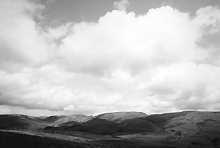
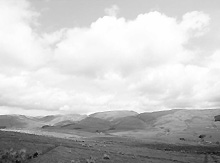
Reversal prints made from slides actually
improve on the low base density and weak highlights of the mono slides -
above left, lanscape print (G4.5) and above right, original slide. The print
below left has better highlight detail
than original, below right.
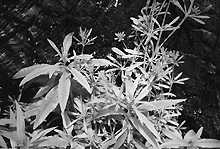
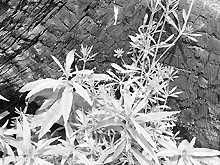
To meet this demand,
Tetenal have produced the SW-Dia Kit which allows transparencies to be made
from black and white negative material, and by using their own Comfort VC
RC paper, black and white reversal prints.
The SW-Dia Kit is presented in
the standard Tetenal packaging with all the chemicals in foil bags except
for the bleach, which is in a 50ml glass bottle. The chemistry consists
of a first developer which is packaged in two parts and mixed with water
to a total volume of 500ml. The remaining chemistry consists of single packets
of clearing bath, second developer and fixing bath; all mix with water to
500ml of working solution. Mixing is very easy and quick as there are no
powders to dissolve.
There is a comprehensive list covering most of the
current black and white films for first developer processing times, the
remaining times being universal for all films. The instructions suggest
that a slow or medium speed film is most suitable for graphic and pictorial
applications although faster films are recommended for lower light levels.
Incidentally, the instructions with this kit are the best that I have seen
with a Tetenal product.
EXPOSING THE FILM
I chose to use Agfapan APX 100
rated at 100 in a range of lighting conditions from flat to very high contrast,
to see just how the process dealt with them. I also bracketed my exposures
which is not my normal practice. However, Tetenal do suggest that tests
are carried out to determine the speed suitable for the lighting conditions.
Tetenal also point out in the instructions that the useful exposure range
in the reversal process is considerably lower than when using the neg-pos
process. I found that when using my usual method of exposing for the shadows
when making black and white negatives the resultant transparencies were
overexposed. Consequently, I reduced exposure by as much as two stops for
the second roll of Agfapan 100 and found the transparencies more acceptable.
FILM DEVELOPMENT
For this reversal process temperature is very important.
I would suggest that a water bath of some description be used. I mixed all
chemicals to 500ml at 20°C as directed in the instructions. Because
the kit will process a maximum of four 120 or 36 exposure 35mm films, I
decanted all solutions into a 500ml container which I placed in the water
bath. To ensure that I used the chemicals in the correct order I numbered
each container as follows, 1 - First Development, 2 - Bleaching,
3 - Clearing, 4 - Second Development and 5 - Fixing. This
is the processing order, except that in between the clearing and the second
development there is a reversal exposure to white light and a 1 to 3 minute
wash in between each process.
The recommended exposure to a 100 to 150 watt
lamp at 12 inches is one minute to both front and back of film with the
film immersed in water to avoid any drops of water on the film causing spots
by lens action. In practice I took the film spiral out of the tank and placed
it in a large clear glass Pyrex jug to allow a more even distribution of
light. Recommended agitation is one inversion every 3 seconds for the first
development followed by one inversion every 15 to 20 seconds for the remaining
baths. The whole development process including the final wash took about
50 minutes.
SLIDE QUALITY
When the dried film was inspected the first thing
that was noticeable was that the film rebate was not the dense black that
I expected, it was a dark grey. The transparencies themselves were reasonable,
although they lack density in the shadows and resemble a print without a
deep rich black to help give it sparkle. The d-max of the first roll was
only 1.7 to 1.8, clear enough to see through if held to the eye, and denser
at the beginning of the 120 rollfilm (outermost in the Paterson white spiral).
There are a number of factors that could be responsible for the result that
I produced from the first test roll that I exposed, but the higher density
on the outside of the spiral indicated that the reversal exposure had been
too short.
I was certain that the first two were not the reason so I decided
to expose a second roll of the same film stock and increase the reversal
exposure from 1 minute for each side to a massive 5 minutes. At the same
time I double checked the temperature of the chemicals although I knew that
they could not be incorrect the first time because I do use a thermostatically
controlled water bath for tests of this nature. The result was better, around
2.0 to 2.1 D, once again denser to the outside of the reel.
I was so concerned
with the discrepancy between instructions and results that I contacted Tetenal's
UK office to ask for advice. Tetenal arranged for Dr Ruediger Freund to
call me from Germany. Dr Freund felt that my processing was satisfactory,
and I have agreed to send the remainder of the kit back to Germany in order
that he can carry out some laboratory tests on it. In the meantime, I will
expose another brand of film in new chemistry and with much more reversal
exposure out of the reel, and report the results in the next issue.
REVERSAL PRINTS
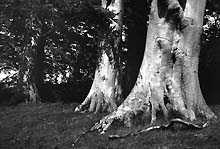 The original
reversal slide (below) contains all the information
from this very contrasty scene, but without much character. The reversal
print, left, has much better tones in the tree trunks, but not in the
shadows.
The original
reversal slide (below) contains all the information
from this very contrasty scene, but without much character. The reversal
print, left, has much better tones in the tree trunks, but not in the
shadows.
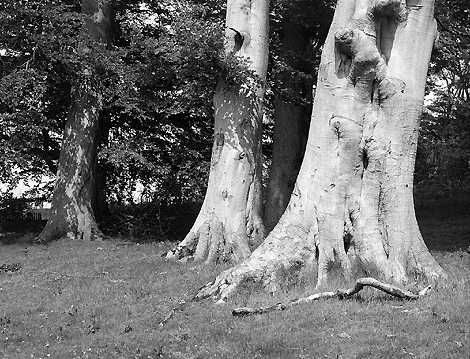
Using the same chemistry and Tetenal's own Comfort VC RC paper black
and white prints can be made from the transparencies, although it is advisable
to use a new kit and not one that has been used to process film stock. The
only difference between processing film and paper is in the timing where
the first development for prints is 5 minutes and every other stage is 1
minute including washing. A test strip is made in the normal way and processed
in the first developer, washed and then bleached all in safelight conditions.
Thereafter all processing is done in normal white light which is an essential
part of the process as the paper, like the film, needs a reversal exposure
which is not too clear in the instructions.
This is the only place that
the instructions are less than clear. I discovered this when I was cutting
paper for test strips and at the same time put a print into the second developer.
Instead of the rapid development that is normal for this stage, the image
did not appear for some time but when the white light was switched on it
very quickly appeared but was degraded. The whole process of making a print
takes about 20 minutes.
Because Tetenal Comfort is a variable contrast paper
grades can be changed in the same way as when printing from negative stock.
I made a number of prints and, because of the contrast of the transparencies,
found that I was printing on the softer grades. However, where too much
exposure had been given at the taking stage resulting in a thin transparency,
I could increase the contrast of the print by using a harder grade. This
is the same principle as printing a thin negative that has been underexposed.
Burning and dodging can be applied but you have to remember that burning
lightens and dodging darkens when printing transparencies.
The prints retained
excellent highlight detail even where the slide original was overexposed.
Generally, they showed a full range of tones and little in the way of grain,
and did not have the excessive contrast which often results from reversal
printing.
CONCLUSION
It is difficult to summarise and comment on the kit.
The contrast range of the slides produced was satisfactory for making prints,
but not for slides to be viewed in the normal way. However, there is no
point in making low-contrast black and white slides from negative material
from which only to make prints. That is merely introducing an unnecessary
modification into the print making process!
When I spoke to Dr Freund it
was clear that Tetenal are very concerned that I report my findings so far.
When Dr Freund carries out his tests on the partly used kit that I am returning
to him, he will let me know whether it is the nature of Paterson reel and
second exposure conditions which affected my films. Perhaps the most significant
thing that we have learned from this test is that we can be content in the
knowledge that Tetenal will listen to the photographer on the street, which
is not always the case with some of the bigger companies in the market place.
Watch this space for further developments, if you will pardon the pun.
- Les McLean
Return to Photon July 96 contents





 The original
reversal slide (below) contains all the information
from this very contrasty scene, but without much character. The reversal
print, left, has much better tones in the tree trunks, but not in the
shadows.
The original
reversal slide (below) contains all the information
from this very contrasty scene, but without much character. The reversal
print, left, has much better tones in the tree trunks, but not in the
shadows.